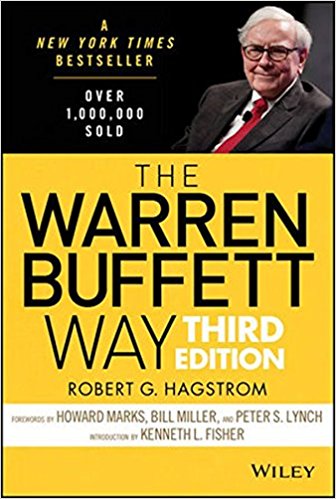The Warren Buffett Way Summary
4 min read ⌚
 Investment Strategies of the World
Investment Strategies of the World
What Einstein is for the world of physics, Warren Buffett is for the world of investing. And when it comes to his investment philosophy – from early influences to late practices – “The Warren Buffett Way” by Robert G. Hagstrom is the essential book, according to many.
Ours, as usually, is the essential summary.
About Robert G. Hagstrom
 Robert G. Hagstrom is one of the world’s leading authors of investment books for the general population. He is the Senior Vice President of Legg Mason Focus Capital, and the author of many bestselling books. In addition to “The Warren Buffett Way,” he has also authored “The NASCAR Way: The Business That Drives the Sport” and “Warren Buffett Portfolio: Mastering the Power of the Focus Investment Strategy.”
Robert G. Hagstrom is one of the world’s leading authors of investment books for the general population. He is the Senior Vice President of Legg Mason Focus Capital, and the author of many bestselling books. In addition to “The Warren Buffett Way,” he has also authored “The NASCAR Way: The Business That Drives the Sport” and “Warren Buffett Portfolio: Mastering the Power of the Focus Investment Strategy.”
“The Warren Buffett Way Summary”
If you’re an investor, probably the only sound way to go is the Warren Buffett way. The man is a legend – not only in the world of finance and investing, but in our world as well.
You know, the world of regular everyday dreamers who like to read rags-to-riches stories and hope that someday luck will start smiling on us as well.
According to Robert G. Hagstrom’s “The Warren Buffett Way,” however, luck has nothing to do with Warren Buffett’s rise and rise. The world’s richest man for many years and the only investor among America’s billionaires for decades started investing in 1956 with $100, 7 limited partners, and $105,000 worth of contributions.
Using his textile firm, Berkshire Hathaway Company, as a vehicle, he managed to build an empire in very short time. And 35 years later, he was worth $8.3 billion. As we said, he didn’t make it that far – he couldn’t have – because of luck; he made it because of many smart and carefully examined decisions.
His main influences were Benjamin Graham and Philip Fisher. The former was his mentor, and the author of two books which are must-reads for any investor, “The Intelligent Investor” and “Security Analysis.” The latter thought Buffett to invest in firms with “above average potential.”
And that is the foundation of Buffett’s investment strategies: ignore markets and portfolios.
Why?
Well, first of all, economies grow and crash, and guessing when either of these two will happen is not unlike guessing which horse will win a race. It depends on many factors, but, it depends on sheer luck as well. And building a portfolio, while probably a good idea in itself, is pointless if it is for the sake of diversifying only.
Especially, if don’t really know the companies on it. For Buffett, “tinkering with a portfolio each day is unwise”; it’s much better to buy only what you know.
And that’s another of Buffett’s fundamental principles: buying a stock is not much different from buying a whole company. Now, you wouldn’t buy a company based on its current market value if you don’t know what it does, would you?
But you would if: a) you understand the company; b) it has long-term potential; c) is managed honestly and effectively; and d) is available at an attractive price.
So, do the same with stocks.
And you’re good to go!
Key Lessons from “The Warren Buffett Way”
1. Warren Buffett Built an Investment Empire With $100
2. Don’t Pay Attention to the Stock Market and/or Economic Cycles
3. You Don’t Need a Diversified Portfolio: Stick to What You Know
Warren Buffett Built an Investment Empire With $100
Warren Buffett started with merely $100 and seven limited partners who contributed with a little more than a $100,000. Just a decade later, he was worth more than $20 million dollars. You know the rest of the story. And you can probably guess from the title that this had nothing to do with luck.
Don’t Pay Attention to the Stock Market and/or Economic Cycles
Most people are all about that fast stocks, fast money mindset. They want to earn money almost instantly. That’s why they spend so much time tinkering with their portfolio. They buy stocks cheaply and attentively follow the market and the economic cycles.
It’s pointless – says Warren Buffett. In that case, they can only hope for luck and nothing more. Because, nobody knows for sure when the stock market will crash. And you’re fooling yourself if you think you can predict it.
You Don’t Need a Diversified Portfolio: Stick to What You Know
Warren Buffett’s Rule #1 is not “don’t lose money.” It’s buy stocks as if you are buying a whole company. And this boils down to at least four principles. First of all, understand what that company does. Secondly, understand how it does it, i.e. is it run by honest and effective managers. Thirdly, examine its long-term (and not short-term) potential. Finally, buy only if the price is right.
And the money will most certainly come. Later – rather than sooner. But, in large amounts.
Like this summary? We’d like to invite you to download our free 12 min app, for more amazing summaries and audiobooks.
“The Warren Buffett Way” Quotes
An investment operation is one which, upon thorough analysis, promises safety of principal and a satisfactory return. Operations not meeting these requirements are speculative. Share on X Successful investing involves the purchase of stocks when the market price of those stocks is at a significant discount to the underlying business value. Share on X You are neither right nor wrong because the crowd disagrees with you: You are right because your data and reasoning are right. Share on X Because emotions are stronger than reason, fear and greed move stock prices above and below a company’s intrinsic value. Share on X Referring to money managers as investors is like calling a person who engages in one-night stands romantic. Share on X
Emir is the Head of Marketing at 12min. In his spare time, he loves to meditate and play soccer.


 Investment Strategies of the World
Investment Strategies of the World



